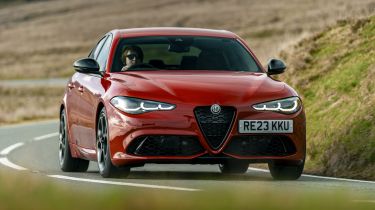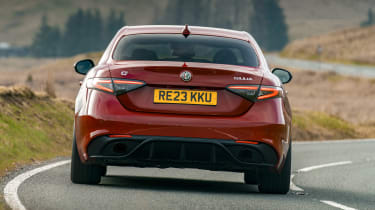Alfa Romeo Giulia saloon - Engines, drive & performance
The Alfa Romeo Giulia strikes the perfect blend of performance and comfort
Rear-wheel drive is favoured by enthusiasts, as the front wheels only have to steer the car rather than providing power as well – leading to what some consider to be a ‘purer’ driving experience. Alfa’s decision to make the Giulia rear-wheel drive pitches it firmly against the BMW 3 Series, which is famous for its excellent handling – although you can also get all-wheel drive on the BMW.
On the road, this decision has clearly been a wise one. The Alfa Romeo Giulia is enjoyable to drive in almost all conditions and can hold its head high against the BMW 3 Series, while it’s more engaging than the Mercedes C-Class. Much of the Giulia’s bodywork and suspension is made from aluminium, helping to keep the car light to boost both fuel economy and driver appeal.
 Top 10 fastest saloon cars 2025
Top 10 fastest saloon cars 2025
While some keen drivers will bemoan the fact that the Giulia isn’t available with a manual gearbox, the eight-speed automatic changes gear quite smoothly and quickly, while optional aluminium paddles on the steering wheel provide the opportunity for greater driver engagement – gear changes in manual mode can be quite jerky, though. The car’s accurate steering makes cornering a pleasure, but it’s very quick to react and so takes some time to get used to. It also means cruising isn’t quite as relaxed as it might be.
More reviews
Alfa Romeo’s DNA selector allows you to choose from three driving modes: Dynamic, Natural and Advanced Efficiency. We found that economy-focused Advanced Efficiency compromised performance a little, as acceleration and gearchanges were too slow with this mode selected. Switch to Natural or Dynamic, however, and the Giulia is far more enjoyable to drive. The brakes feel firm and consistent, with noticeably less pedal travel in Dynamic mode for extra precision.
Body lean in corners is minimal thanks to the Giulia’s stiff suspension, though this does mean it becomes a little uncomfortable over poor roads. The Competizione version addresses this deficit though, as it brings adjustable suspension with settings to help filter out the worst bumps. Veloce trim and the range-topper also include a limited-slip differential – a mechanical component that allows a car to put its power down more effectively, especially when cornering.
Alfa Romeo Giulia petrol engines
Despite its relatively high running costs, the 197bhp 2.0-litre petrol engine was a good choice when available, being quieter, smoother and punchier than the diesels. Currently, the only engine option is the 276bhp 2.0-litre petrol, making the Giulia pretty quick, with 0-62mph taking just 5.7 seconds. The BMW M340i xDrive is even faster though, taking just 4.4 seconds to hit the same benchmark.
Unlike the aforementioned BMW, the Giulia is only offered with rear-wheel-drive in the UK. Its engine feels potent and keen to rev, while changing gear with the metal paddles is a delight. It’s also a fairly flexible engine thanks to its turbocharging, so you don’t have to be worried about always being in the right gear to pick up some speed if you need to. Considering how squarely the Giulia is aimed at keen drivers, it’s also a positive that acceleration goes hand-in-hand with a throaty soundtrack.
Taking another big step up, the Quadrifoglio gets a 2.9-litre twin-turbo V6 with 503bhp and 600Nm of torque, and we’ve reviewed it in-depth separately. Its Ferrari connections can be felt in its keenness to rev, while its official 0-62mph time of 3.9 seconds and a top speed of 192mph show just how potent it is.
Diesel engines
The 2.2-litre diesel was available with either 158 or 187bhp. We drove the more powerful version and can heartily recommend it on the used market, but it’s no longer offered in showrooms. With this 187bhp engine, the Giulia can go from 0-62mph in just 7.1 seconds, yet fuel economy is still decent, if not quite on a par with the similarly powerful (though slightly slower) BMW 320d. It feels keen to rev and muscular, with a linear power delivery. The 158bhp diesel engine was cheaper to buy, but it’s still reasonably brisk, with 0-62mph taking 8.2 seconds.













